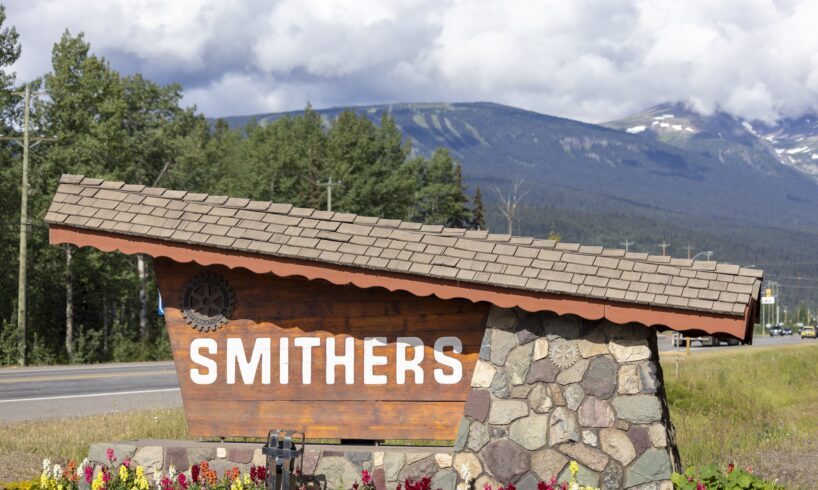
Open this photo in gallery:
After three drillers were rescued from Red Chris mine this week in Smithers, B.C., residents are relieved but reminded of the safety concerns of the mining industry.Aaron Whitfield/The Globe and Mail
After two-and-a-half days locked in a northern B.C. mine, separated from the surface by a mound of rockfall, three drillers waved to their families from across the tarmac at Smithers Airport.
It was an emotional embrace for some on Friday afternoon, a more muted greeting for others. Harvey Tremblay, watching his employees reconnect with their families, felt a unique relief.
“I think it’s a responsibility, having employees, and so it does have a bit of weight, certainly. Events like this are probably the worst part of owning a business – you feel that somebody may get hurt,” Mr. Tremblay, the owner and co-founder of Hy-Tech Drilling, told The Globe and Mail in an interview.
“You want everybody to have careers and come home to their family safe. So when everything was completed, and the guys were back and the families were reunited, you could just feel the weight lifting after. You don’t even realize it’s there.”
The three drillers had been working in the Red Chris mine, a gold and copper site about 366 kilometres northwest of Smithers, B.C., when a collapse on Tuesday at the mine’s access trapped them 284 metres underground.
Inside the effort to free B.C. miners trapped for more than 60 hours
Smithers, a quiet and close-knit rural community of 5,400 in British Columbia’s forested and mountainous northwest, suddenly became the centre of international attention as rescuers planned how to free the miners.
The resource town is one of B.C.’s most prominent mining hubs. Smithers is just southeast of what is known as Northern B.C.’s Golden Triangle, an area that includes most of the gold, silver and copper deposits in the west-central Stikine region. The Red Chris mine is located at the triangle’s northern edge.
Both logging and mining have been economic drivers in Smithers, but mining has been the town’s fastest growing industry. The provincial government has embraced mining projects, envisioning expansion of critical minerals extraction as a sure way toward loosening dependence on B.C.’s – and Canada’s – reliance on the U.S.
Open this photo in gallery:
Harvey Tremblay, owner and co-founder of Hy-Tech Drilling in Smithers, B.C., said he felt a ‘weight lifting’ after his three employees had been rescued.Aaron Whitfield/The Globe and Mail
Mr. Tremblay co-founded Hy-Tech in the town in 1991 with one drill operation. It focuses on core drilling and sampling, the former being a method which characterizes the ore body during exploration and mining.
Hy-Tech is among approximately 100 mining companies that contribute to Smithers’ economy. It’s grown to roughly 1,000 employees in six countries, but has maintained its headquarters in the B.C. town. (Mining companies have operations offices within Smithers, even though the projects can be distant.)
Even for those in Smithers who may not have personally known the three men trapped last week, residents say the collapse was alarming – and that the rescue was a collective relief.
The first rockfall, Mr. Tremblay heard from the drillers, was insignificant. They hadn’t even heard it. But had they tried to exit, things could have gone much worse.
Instead, the men stuck to their training and went to a refuge bay – a reinforced area stocked with food, water and proper ventilation – before a second, much more significant rock fall, trapped them and left them with no communication.
One of the three, Kevin Coumbs from Ontario, has a wealth of mining experience, including as a driller, Mr. Tremblay said. Normally, there would be two people on the drill, but Mr. Coumbs had been helping onboard a driller new to Hy-Tech.
He was “more comfortable with the situation that he found himself in. Not everybody would be calm under those conditions,” Mr. Tremblay said.
The others with Mr. Coumbs was B.C. resident Darien Maduke and Jesse Chubaty from Manitoba. Mr. Coumbs and Mr. Chubaty did not respond to The Globe’s requests for comment, and Mr. Maduke could not be reached.
Mr. Tremblay said there was a small team from Hy-Tech that communicated updates to the family of the drillers, who were struggling with the uncertainty in the mine. He said the company contacts bonded with the family over that time.
After they were extricated from the mine, the rescued drillers appeared to be handling the stress well, Mr. Tremblay said, but there would be supports available to them if needed.
Open this photo in gallery:
Long time Smithers locals Doug Brown, left, and Randy Besner have a drink in downtown Smithers. Besner says the Red Chris incident makes him worried about his son, who works in the mining industry.Aaron Whitfield/The Globe and Mail
When long-time Smithers resident Randy Besner heard about the collapse at Red Chris, he had initially been told it was at the nearby Brucejack mine, where his son worked.
“I worry about my son, now, doing it, and yeah, just your heart sunk,” said Mr. Besner, who works in the logging sector and had just gotten off shift Friday.
However, he still stands behind the mining sector, saying he would be in the industry if he was a bit younger.
Open this photo in gallery:
The Smithers municipal administration supports the local mining industry, which in turn offers community partnerships and sponsorships.Aaron Whitfield/The Globe and Mail
In Smithers, the town administration and town council support mining companies. In turn, businesses reciprocate with sponsorships and as community partners. Town officials say there’s an economic benefit for Smithers from the sector, even if the town is not directly involved in projects.
But not everyone supports the industry; mining has long been divisive in B.C.
Linnea Eldred, a Smithers resident for just about a decade, said she’s concerned about the effect the mining industry has on the environment.
“I think it would be better if the mining industry, especially up here, were to err on the side of caution,” Ms. Eldred said.
While Smithers is considered a mining hub, she said she also feels a disconnect between the town and the sector. She sees the direct financial reward for workers, but isn’t clear on how the economic benefit trickles down to other townsfolk.
Open this photo in gallery:
Newmount Mining Corp., the majority owner of Red Chris mine, will be conducting a “comprehensive investigation” into the incident.Aaron Whitfield/The Globe and Mail
Mr. Tremblay said he hadn’t sat down with the Red Chris mine’s majority owner, Newmont Mining Corp., to discuss continuing operations. He expects open pit mining will continue as normal while the collapse is investigated.
In a news release, Newmont said it will be conducting a “comprehensive investigation” into the incident and will share the lessons learned across the industry.
Mining can be a dangerous job, and workers know that, but training and preparation prevailed, Smithers Mayor Gladys Atrill said.
“Terrible circumstances are an opportunity to learn,” she said.
With files from Kate Helmore





